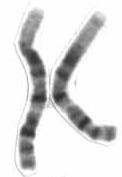Chromosome 1 is the designation for the largest human chromosome. Humans have two copies of chromosome 1, as they do with all of the autosomes, which are the non-sex chromosomes. Chromosome 1 spans about 249 million nucleotide base pairs, which are the basic units of information for DNA. It represents about 9% of the total DNA in human cells.
Identifying genes on each chromosome is an active area of genetic research. Because researchers use different approaches to genome annotation their predictions of the number of genes on each chromosome varies. In January 2017, two estimates differed by 12%, with one estimate giving 5,078 genes, and the other estimate giving 4,474 genes.
It was the last completed chromosome, sequenced two decades after the beginning of the Human Genome Project.
The following are some of the genes located on chromosome 1:
AHCTF1: encoding protein ELYS
AMPD2: encoding enzyme AMP deaminase 2
ARID4B: encoding protein AT-rich interactive domain-containing protein 4B
AZIN2: encoding enzyme Antizyme inhibitor 2 (AzI2) also known as arginine decarboxylase (ADC)
C1orf21: encoding protein Uncharacterized protein C1orf21
C1orf49: encoding protein Uncharacterized protein C1orf49
C1orf103: encoding protein Ligand-dependent nuclear receptor-interacting factor 1 (LRIF1)
ACADM: acyl-Coenzyme A dehydrogenase, C-4 to C-12 straight chain
COL11A1: collagen, type XI, alpha 1
CPT2: carnitine palmitoyltransferase II
DBT: dihydrolipoamide branched chain transacylase E2
DIRAS3: DIRAS family, GTP-binding RAS-like 3
ESPN: espin (autosomal recessive deafness 36)
GALE: UDP-galactose-4-epimerase
GJB3: gap junction protein, beta 3, 31kDa (connexin 31)
HMGCL: 3-hydroxymethyl-3-methylglutaryl-Coenzyme A lyase (hydroxymethylglutaricaciduria)
KCNQ4: potassium voltage-gated channel, KQT-like subfamily, member 4
KIF1B: kinesin family member 1B
MFN2: mitofusin 2
MTHFR: 5,10-methylenetetrahydrofolate reductase (NADPH)
MUTYH: mutY homolog (E. coli)
NGF: Nerve Growth Factor
PARK7: Parkinson disease (autosomal recessive, early onset) 7
PINK1: PTEN induced putative kinase 1
PLOD1: procollagen-lysine 1, 2-oxoglutarate 5-dioxygenase 1
TACSTD2: tumour-associated calcium signal transducer 2
TMEM48: encoding protein nucleoporin NDC1
TSHB: thyroid stimulating hormone, beta
UROD: uroporphyrinogen decarboxylase (the gene for porphyria cutanea tarda)
ASPM: a brain size determinant
CRP: C-reactive protein
F5: coagulation factor V (proaccelerin, labile factor)
FMO3: flavin containing monooxygenase 3
GBA: glucosidase, beta; acid (includes glucosylceramidase) (gene for Gaucher disease)
GLC1A: gene for glaucoma
HFE2: hemochromatosis type 2 (juvenile)
HPC1: gene for prostate cancer
IRF6: gene for connective tissue formation
LMNA: lamin A/C
MPZ: myelin protein zero (Charcot–Marie–Tooth neuropathy 1B)
MTR: 5-methyltetrahydrofolate-homocysteine methyltransferase
PPOX: protoporphyrinogen oxidase
PSEN2: presenilin 2 (Alzheimer disease 4)
SDHB: succinate dehydrogenase complex subunit B
TNNT2: cardiac troponin T2
USH2A: Usher syndrome 2A (autosomal recessive, mild)
Chromosome 1 contains 246 million base pairs
Diseases and disorders
There are 890 known diseases related to this chromosome. Some of these diseases are hearing loss, Alzheimer disease, glaucoma and breast cancer. Rearrangements and mutations of chromosome 1 are prevalent in cancer and many other diseases. Patterns of sequence variation reveal signals of recent selection in specific genes that may contribute to human fitness, and also in regions where no function is evident. The following diseases are some of those related to genes on chromosome 1 (which contains the most known genetic diseases of any human chromosome):

